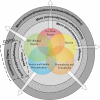HIV, gender, race, sexual orientation, and sex work: a qualitative study of intersectional stigma experienced by HIV-positive women in Ontario, Canada
- PMID: 22131907
- PMCID: PMC3222645
- DOI: 10.1371/journal.pmed.1001124
HIV, gender, race, sexual orientation, and sex work: a qualitative study of intersectional stigma experienced by HIV-positive women in Ontario, Canada
Abstract
Background: HIV infection rates are increasing among marginalized women in Ontario, Canada. HIV-related stigma, a principal factor contributing to the global HIV epidemic, interacts with structural inequities such as racism, sexism, and homophobia. The study objective was to explore experiences of stigma and coping strategies among HIV-positive women in Ontario, Canada.
Methods and findings: We conducted a community-based qualitative investigation using focus groups to understand experiences of stigma and discrimination and coping methods among HIV-positive women from marginalized communities. We conducted 15 focus groups with HIV-positive women in five cities across Ontario, Canada. Data were analyzed using thematic analysis to enhance understanding of the lived experiences of diverse HIV-positive women. Focus group participants (n = 104; mean age = 38 years; 69% ethnic minority; 23% lesbian/bisexual; 22% transgender) described stigma/discrimination and coping across micro (intra/interpersonal), meso (social/community), and macro (organizational/political) realms. Participants across focus groups attributed experiences of stigma and discrimination to: HIV-related stigma, sexism and gender discrimination, racism, homophobia and transphobia, and involvement in sex work. Coping strategies included resilience (micro), social networks and support groups (meso), and challenging stigma (macro).
Conclusions: HIV-positive women described interdependent and mutually constitutive relationships between marginalized social identities and inequities such as HIV-related stigma, sexism, racism, and homo/transphobia. These overlapping, multilevel forms of stigma and discrimination are representative of an intersectional model of stigma and discrimination. The present findings also suggest that micro, meso, and macro level factors simultaneously present barriers to health and well being--as well as opportunities for coping--in HIV-positive women's lives. Understanding the deleterious effects of stigma and discrimination on HIV risk, mental health, and access to care among HIV-positive women can inform health care provision, stigma reduction interventions, and public health policy.
Conflict of interest statement
LJ was the Research Coordinator of the study and the data cited in the article submitted to PLoS. LJ was financially compensated for that role. The study received funds from CIHR and the Ontario AIDS Bureau, Ministry of Health and Long Term Care (they did not provide input or participate in the study or data analysis in any manner). The community- based agency, Women's Health in Women's Hands Community Health Centre (WHIWH) housed the study, administered the funds and all related contracts. LJ was paid by WHIWH as per the contract agreement. All other authors have declared that no competing interests exist.
Figures

References
-
- PHAC. HIV and AIDS in Canada. Surveillance Report to December 31, 2008. Ottawa: Public Health Agency of Canada; 2009.
-
- UNAIDS. UNAIDS Report on the Global AIDS Epidemic. Geneva: UNAIDS; 2010.
-
- Newman PA, Williams CC, Massaquoi N, Brown M, Logie C. HIV prevention for Black women: structural barriers and opportunities. J Health Care Poor Underserved. 2008;19:829–841. - PubMed
-
- Williams CC, Newman PA, Sakamoto I, Massaquoi NA. HIV prevention risks for Black women in Canada. Soc Sci Med. 2009;68:12–20. - PubMed
-
- Tharao E, Massaquoi N, Teclom S. Silent voices of the HIV/AIDS epidemic: African and Caribbean Women Research Study (2002–2004) Toronto: Women's Health in Women's Hands; 2006.
Publication types
MeSH terms
Grants and funding
LinkOut - more resources
Full Text Sources

